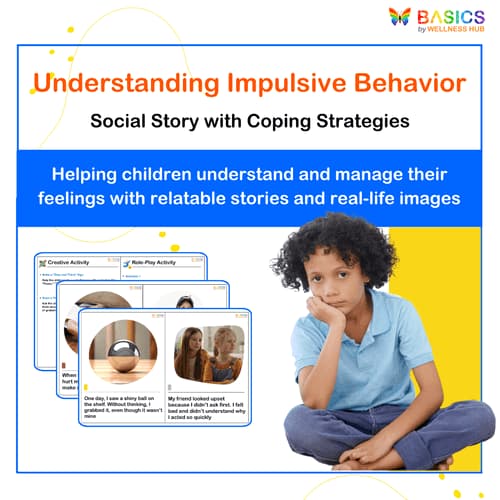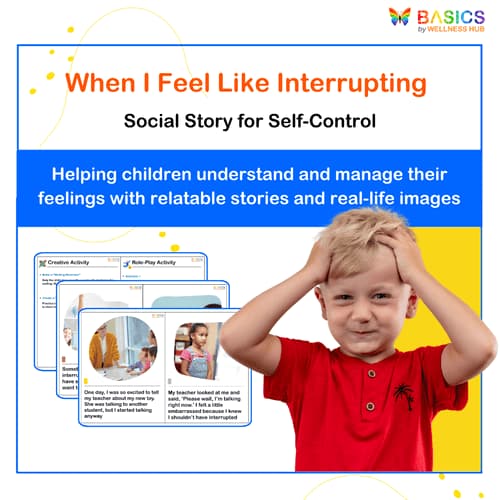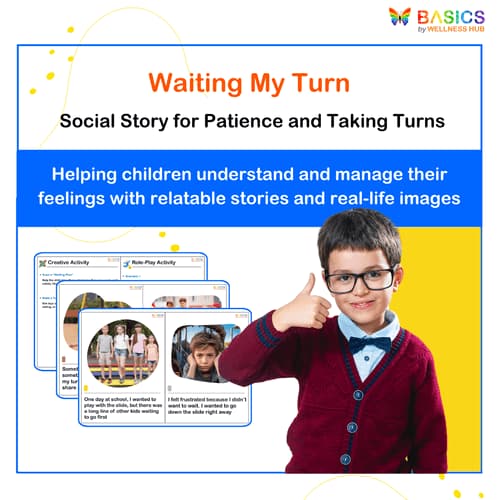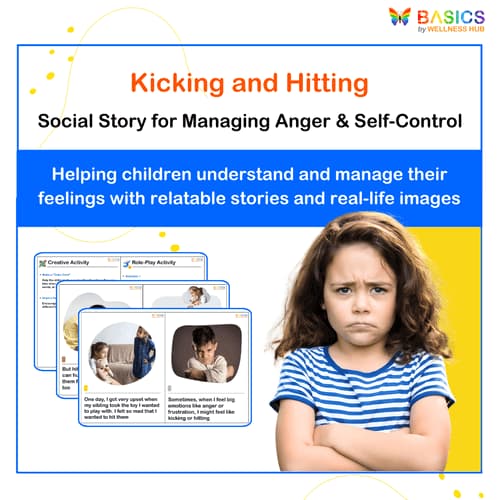





Dealing with Anger: A Social Story for Children
₹80
₹160
50% off
0 (0 ratings)
Grade Levels
Pre-K - Grade 2 (Ages 3-8)
Content Overview
1 PDF with 6 pages; 12 statements with real-life images. Features Segment: Engaging visuals; practical coping strategies for anger management.
Categories
Pages from the Resource
This social story, Dealing with Anger, helps young children understand and manage their feelings of anger. Through first-person narration and real-life images, it offers practical strategies for coping with anger, making it an ideal resource for parents, educators, and therapists working with children aged 3-8.

Page 1

Page 2
What Users Say
0
0 ratings
5
0+
4
0+
3
0+
2
0+
1
0+
5 Stars
Product is Good to use.
10 months ago
Varsha Parent
Similar Products

Understanding Impulsive Behavior: Social Story with Coping Strategies
₹ 80.00
₹ 160.00
50% off
4.9 (42 ratings)

When I Feel Like Interrupting – Social Story for Self-Control
₹ 80.00
₹ 160.00
50% off
4.8 (60 ratings)

Waiting My Turn – Social Story for Patience and Taking Turns
₹ 80.00
₹ 160.00
50% off
4.7 (56 ratings)

Kicking and Hitting – Social Story for Managing Anger & Self-Control
₹ 80.00
₹ 160.00
50% off
4.6 (52 ratings)

Understanding Swear Words – Social Story for Respectful Communication
₹ 80.00
₹ 160.00
50% off
4.9 (48 ratings)
About the Product
Purpose of Flashcards: The "Dealing with Anger" social story is thoughtfully designed to help young children understand and manage their anger in a healthy and constructive way. Presented in a relatable, first-person narrative, this resource uses real-life scenarios with high-quality images that reflect a continuous storyline. The story guides children through the process of identifying and coping with anger, providing them with practical techniques to calm themselves in emotionally charged situations. This resource is ideal for parents, teachers, and therapists who want to empower children with self-regulation skills.
Product Details
Format: 1 PDF file with 6 pages
Content: The story is divided into 12 segments, with each page containing 2 statements accompanied by realistic images that depict the narrative. The text is written in first-person language to create a personal connection for the child.
Design: High-quality, real-life images accompany each statement, maintaining a sense of continuity and realism throughout the story. The images are carefully selected to depict emotions and actions that align with each part of the narrative.
Features: 6-page social story with realistic images, first-person narrative, and anger management techniques.
Educational Benefits
Emotional Awareness and Expression: This resource helps children recognize and articulate their emotions, specifically focusing on feelings of anger. By understanding that anger is a natural emotion, children learn to accept it without fear or shame.
Coping Strategies: The story introduces children to healthy coping mechanisms for anger, such as deep breathing, positive self-talk, and taking a break. These strategies are modeled within the narrative, making them easy for children to remember and apply.
Behavioral Regulation: By following the steps in the story, children learn how to pause, reflect, and choose appropriate actions when feeling angry. This promotes self-regulation and reduces impulsive behaviors.
Social Skills Development: The story subtly teaches children how to communicate their feelings and seek help in a calm manner, fostering better social interactions with peers and adults.
Instructions for Use
Reading the Story: Introduce the story during a calm time, when the child is receptive to learning. Read through it slowly, pausing at each segment to discuss the images and ask how the child would feel in similar situations.
Reinforcing Concepts: After reading, revisit the story during moments when the child is experiencing anger or frustration. Use the story as a reference point to help the child recall and apply the strategies they learned.
Incorporating Into Routines: Make this social story a regular part of your emotional regulation activities. Repetition is key to helping children internalize the coping strategies presented.
Customizing the Experience: Feel free to add personal anecdotes or examples to make the story more relatable to the child. You can even involve the child in acting out the scenarios to enhance their understanding and retention.
Monitoring Progress: Observe the child over time to see how they respond to challenging situations. Use the story as a tool for reflection when discussing past incidents, helping the child recognize their growth in managing anger.
Activities Using the Resource
Role-Playing Anger Management: After reading the story, engage the child in role-playing scenarios where they pretend to feel angry. Prompt them to recall and use the strategies from the story, like taking deep breaths or finding a quiet space. This activity reinforces the coping mechanisms and makes them more accessible when the child faces real-life situations.
Emotion Chart: Create an emotion chart with the child, where they can track how they’re feeling each day. Discuss their feelings at the end of the day and use the social story to revisit coping techniques if anger was an issue. Over time, the chart can help the child identify patterns and triggers for their anger.
Visual Cues and Reminders: Place visual reminders from the story around the home or classroom. For example, a sign with “Take a deep breath” or “Find a calm spot” can cue the child to remember the strategies when they start feeling frustrated. These cues create continuity between the story and real-life application.
Story Sequencing: Print out images from the story and ask the child to arrange them in the correct order. Discuss each segment as they sequence the events, reinforcing the steps for managing anger. This activity strengthens comprehension and memory of the strategies.
Creative Expression: Encourage the child to draw or write about a time they felt angry and how they coped with it, inspired by the story. They can share their drawing or story and discuss how they felt before and after using the strategies. This builds self-reflection and emotional literacy.
FAQs
Q1: Can this social story be used with children of different age groups?
A1: Yes, the story is designed for early childhood but can be adapted for older children who may need support in managing their emotions. The language and images are clear and relatable, making it accessible for a range of ages.
Q2: How often should I use this story with my child?
A2: Regular repetition is beneficial. You can read it daily or whenever the child shows signs of struggling with anger. Over time, the strategies will become second nature as the child gains confidence in managing their emotions.
Q3: My child finds it difficult to apply the strategies in real-time. How can I help?
A3: It’s normal for children to need practice before they can independently use coping strategies. Role-playing and reinforcing the story during calm moments can help them practice in a low-pressure environment. Also, gentle reminders during challenging moments can help them recall the strategies.
Q4: Can I use this story alongside other emotional regulation tools?
A4: Absolutely! This social story works well with tools like emotion charts, calming jars, and mindfulness exercises. The more comprehensive the emotional toolkit, the better equipped your child will be.
Q5: How do I handle situations where the story doesn’t seem to help?
A5: Every child is different, and some may need more time or a different approach. Consistency is key, but if your child continues to struggle, consider consulting a child therapist who can provide additional strategies tailored to their needs.
Usage Rights and Restrictions
Personal Use Only: The "Dealing with Anger" social story is intended for personal use by the purchaser in a single home or classroom setting.
No Distribution or Sharing: The PDF should not be distributed, shared, or resold in any form, whether digital or physical.
No Commercial Use: The resource cannot be used for commercial purposes, including mass production or integration into paid programs.
Customization for Personal Use: Minor customizations, like adding personalized images or examples, are allowed for personal use, but the content should not be altered in a way that changes its core message.
Conclusion
The "Dealing with Anger" social story is a valuable tool designed to guide children through the process of understanding and managing their emotions in a positive way. With relatable real-life scenarios, high-quality visuals, and a focus on practical coping strategies, this story provides children with the tools they need to navigate their feelings with confidence. By consistently engaging with this resource, children will gradually learn to apply these techniques in real-life situations, leading to improved emotional regulation and healthier relationships.



